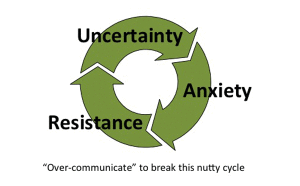Editor's Note: Take a look at our featured best practice, Change Management Strategy (24-slide PowerPoint presentation). Seventy percent of change programs fail, according to the April 2001 Harvard Business Review article, "Cracking the Code of Change". According to Bain & Company, businesses that implement fast, focused, and simultaneous change programs can create enormous and long-lasting shareholder [read more]
8 Transformational Levers for BIG Organizational Change
Also, if you are interested in becoming an expert on Change Management, take a look at Flevy's Change Management Frameworks offering here. This is a curated collection of best practice frameworks based on the thought leadership of leading consulting firms, academics, and recognized subject matter experts. By learning and applying these concepts, you can you stay ahead of the curve. Full details here.
* * * *
There are plenty of theories on change management, and this isn’t one of them. This is a simple checklist for anyone driving big, complex organizational change.
But first, you have to recognize when you are facing what we’ll call “Big Change.” Some examples: You are changing leaders, and the new person is bringing new “direction.” Or, you are downsizing or consolidating. Or, you are fixing an organization-wide problem with maintenance, safety, or something. Or, you are moving the location of a factory. The list is endless, but you get the picture.
It’s the “Soft Side”
That Makes Change Hard There are two sides to the Big Change coin (pun intended). First, there is the “hard side,” the physical details that will – or had better – end up in a project plan, complete with pretty Gantt charts. The other side of the coin is the “soft side,” the people stuff. Of course, it’s the soft side of change management that makes Big Change hard. And if you think that the soft side is too squishy to be managed in any hard-headed way, you might be surprised.
8 Transformational Levers: MICE ROAR
There is a handful of “people systems” that can be your
This checklist calls out those invisible forces and makes them available as transformational levers. The point is to put transformational levers IN YOUR PLAN, right alongside “select moving company.” You want to get all the arrows to point in the same direction at the right time.
Most of these transformational levers can be used to get you through the change, and they can also be used on the other side of the change to sustain it. Here, we’re just talking about using them to get you through the change. For example, the first lever, Measurement, could remind you to measure how many people are, say, trained in a new process, how many have adopted the new process, how much re-work is required as they get used to the new process, and so on. On the other side of change, you will want to measure outcomes, such as the degree to which you are getting the benefits of the new process (reduced costs, cycle time, up time, whatever). But that’s another story and not the point we’re trying to make here.
So, as you read the list, think about how you might use it to get through the change; if you think about it for other purposes, that’s a bonus.
We call this our MICE ROAR checklist (thanks to Jeff Kenyon, software guru and graduate of our Implementing Strategic Change course, for sorting our list into a clever acronym). If you have thoughtfully addressed these levers in your planned change, you should do pretty well. They are:
• Measurement
• Involvement
• Communication
• Education & Training
• Reinforcement
• Organizational Structure
• Accountability Processes
• Resourcing
Here’s a little more detail on each one:
- “What gets measured gets done” isn’t exactly true; you must attach consequences to your outcomes. However, there is no better spotlight, nor better foundation for consequences, than measurement. You can measure processes: how well you are doing what you say you’re doing. Or, you can measure outcomes: the results of your processes.
- Everyone writing about change agrees that involvement of people affected by the change is important. The underlying reason is that people hate feeling out of control of important parts of their lives. In a change project this lack of comfort quickly leads to massive resistance. To avoid this you must give the people affected by the change a serious opportunity to influence the nature of the change and how it is implemented, and you must take their ideas seriously. (Some helpful clarifications on this paragraph: “opportunity” does not mean that all must give their opinions; “influence” does not mean control; “ideas taken seriously” does not equate with getting one’s way.)
Along with the generalized resistance to change that occurs when people feel out of control, is the anxiety that comes from not knowing what’s going on. The problem is that people don’t hear well when they’re resisting, so their uncertainty doesn’t go away when rational explanations are offered. If anything, resistance increases, causing another escalation of anxiety and resistance. The only way to break this vicious circle is communication, and lots of it! (As a good starting point, consider William Bridges’ 7X7 principle: Communicate it seven times, seven different ways. His wise book, Managing Transitions, is highly recommended.)
- Education (and training) is straightforward. It simply means that people must be knowledgeable of the vision, values, goals and objectives of the organization, and must be equipped with the skills necessary for their new jobs. People must also be educated about the transformational change and trained on the skills necessary to execute the transformational change. Keep in mind the principle of just-in-time training, which means DON’T teach somebody how to do something wayyyy before they’ll be able to use it; they just forget.
- We all know that people generally do whatever gets them rewarded. It’s pretty obvious that the reinforcement system needs to be changed whenever there’s a strategic change to the work that people do. We take a broad view of the reinforcement system, and include in it the way people get paid (and what they get paid for), their benefits, other financial rewards, and non-financial forms of reward and recognition.
- The term Organizational Structure refers to three things: (1) Accountability Hierarchy, the lines and boxes on an organizational chart (who’s accountable to whom for what), (2) process design (the lines and boxes on a process flow chart), and (3) position descriptions. If you have names that you plan to match with positions, that is good to include also. As with all transformational tools, you will have some elements that you install only during the transformational change, and some that will endure after the transformational change. Therefore you will have some Organizational Structure considerations that are temporary – say, the design of the project team. And you will have some design considerations that are permanent, such as the design of the organization being changed.
- Accountability Processes – sometimes called performance management – are the processes by which you hold people accountable. Implementation of strategic change, by definition, affects the work for which people are held accountable. So at this time it is especially crucial to have processes through which to ensure the three elements of accountability (clarity of request, buy-in, and performance consequences). During the change you will need more frequent review goal setting/review intervals. For example, during a big change with the entrenched staff of a not-for-profit organization, we found weekly review intervals to be especially helpful in turning things around. As the change took root, then monthly intervals sufficed.
- Resourcing is about getting the right people into the right jobs, either by external recruitment or through internal postings. It also includes succession planning. Big change often shifts the requirements of key positions, calling for different personal attributes and skills by the people in those positions; when it does, resourcing efforts need to have been thought out in advance and kicked into gear.
We are big believers in checklists (for inspiration on that point, see Atul Gawande’s The Checklist Manifesto) and we hope you find this one useful.

Want to Achieve Excellence in Change Management?
Gain the knowledge and develop the expertise to become an expert in Change Management. Our frameworks are based on the thought leadership of leading consulting firms, academics, and recognized subject matter experts. Click here for full details.
"The only constant in life is change." – Heraclitus
Such is true for life, as it is for business. The entire ecosystem our organization operates in—our customers, competitors, suppliers, partners, the company itself, etc.—is constantly changing and evolving. Change can be driven by emerging technology, regulation, leadership change, crisis, changing consumer behavior, new business entrants, M&A activity, organizational restructuring, and so forth.
Thus, the understanding of, dealing with, and mastery of the Change Management process is one of the most critical capabilities for our organization to develop. Excellence in Change Management should be viewed as a source of Competitive Advantage.
Learn about our Change Management Best Practice Frameworks here.
Readers of This Article Are Interested in These Resources

|
|
286-slide PowerPoint presentation
|
|
73-slide PowerPoint presentation
| |||
Top 10 Recommended Documents on Change Management
» View more resources Change Management here.
» View the Top 100 Best Practices on Flevy.


 Along with the generalized resistance to change that occurs when people feel out of control, is the anxiety that comes from not knowing what’s going on. The problem is that people don’t hear well when they’re resisting, so their uncertainty doesn’t go away when rational explanations are offered. If anything, resistance increases, causing another escalation of anxiety and resistance. The only way to break this vicious circle is communication, and lots of it! (As a good starting point, consider William Bridges’ 7X7 principle: Communicate it seven times, seven different ways. His wise book, Managing Transitions, is highly recommended.)
Along with the generalized resistance to change that occurs when people feel out of control, is the anxiety that comes from not knowing what’s going on. The problem is that people don’t hear well when they’re resisting, so their uncertainty doesn’t go away when rational explanations are offered. If anything, resistance increases, causing another escalation of anxiety and resistance. The only way to break this vicious circle is communication, and lots of it! (As a good starting point, consider William Bridges’ 7X7 principle: Communicate it seven times, seven different ways. His wise book, Managing Transitions, is highly recommended.)










